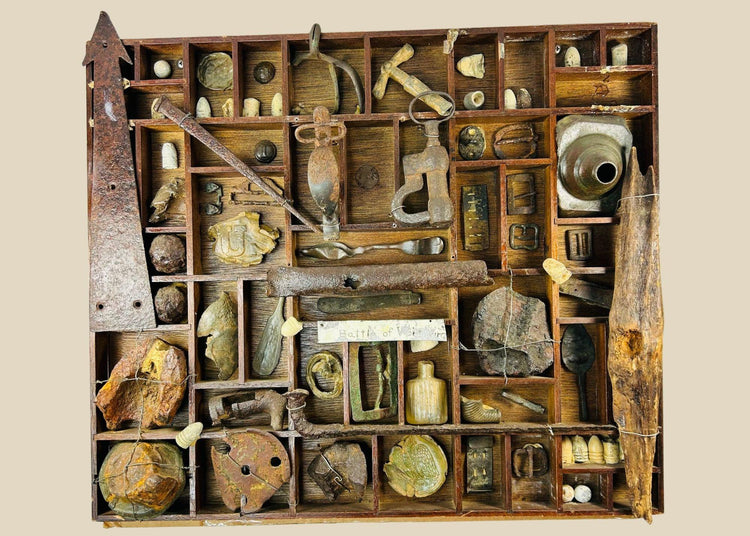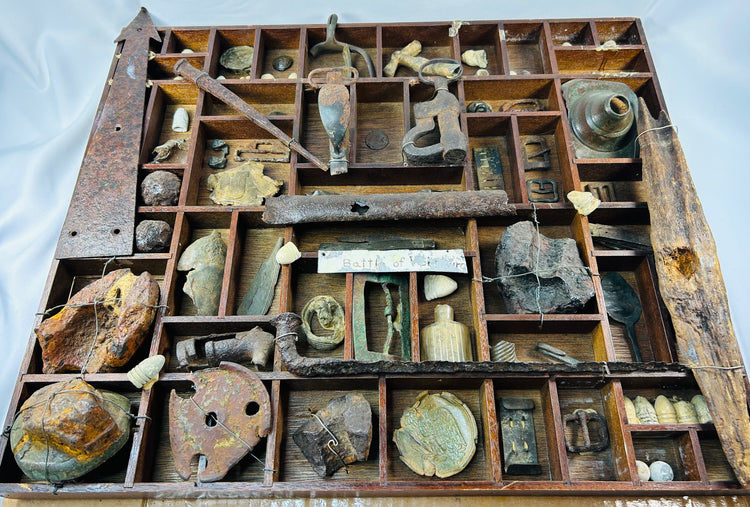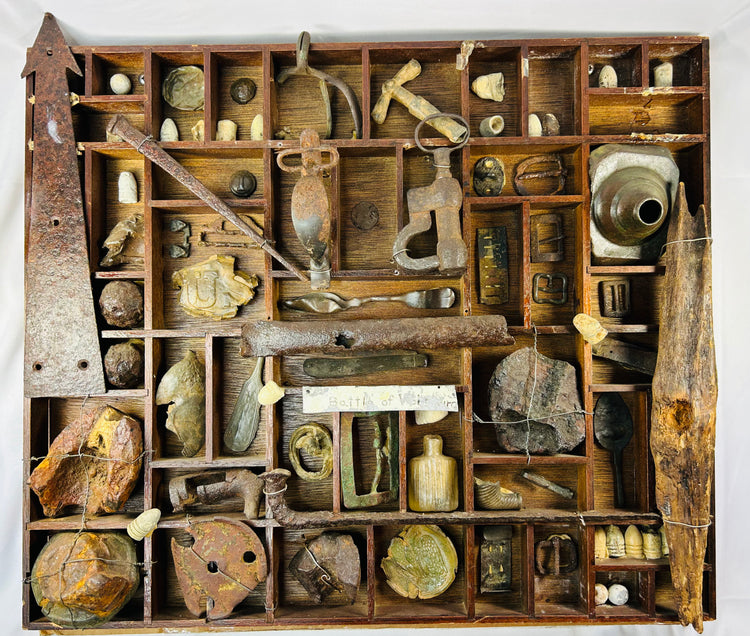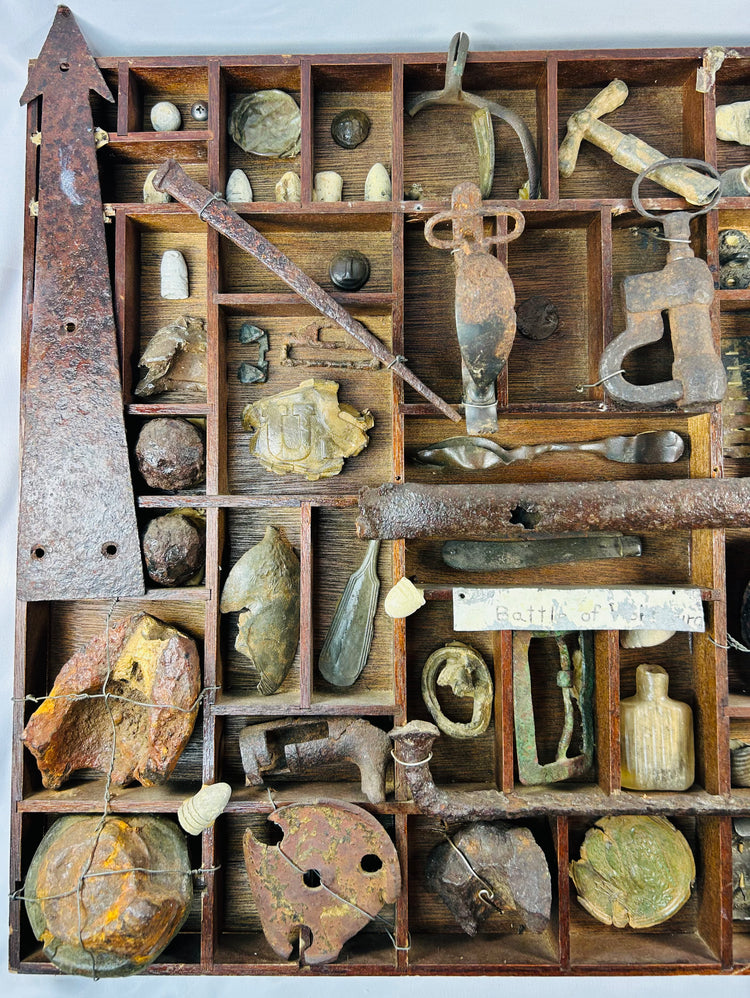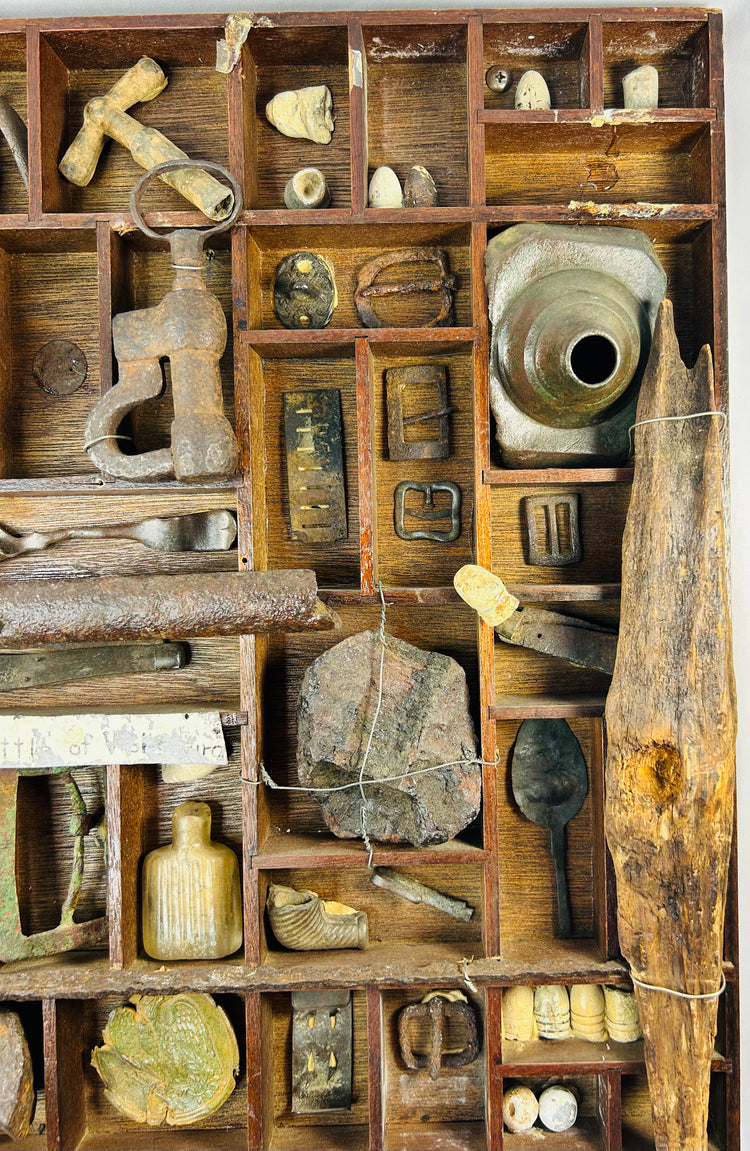Vicksburg Campaign Battlefield Finds | Compartmented Display Collection | Circa 1861–1865
Description
More
Less
Historical Context & Origin
Region: United States, Mississippi Valley (attributed)
Material: Mixed metals (iron, brass, lead), glass/ceramic, wood display tray with wire mounts
Period: American Civil War, ca. 1861–1865
Description
Large, visually striking shadow-box assemblage of dug Civil War relics, mounted in a compartmented wooden tray. An old hand-written label reads “Battle of Vicksburg,” suggesting the items were recovered in or around that campaign; the group appears to have been arranged by a mid-20th-century collector and left largely undisturbed since. Contents include multiple Minie balls and carved bullets, round-shot/canister and shell fragments, horse equipment (spur, stirrup, buckles), accoutrement hardware (US plate and eagle breastplate fragments, belt/suspender buckles, knapsack/strap fittings, scabbard piece), canteen spout, pipe bowl fragment, glass bottle, iron tools and camp items, and miscellaneous brass/lead field finds—all with honest excavated patina.
Features
- Compartmented wooden display with dozens of identified relics
- Highlights: US oval plate fragment, eagle motif disk, spur & stirrup, canteen spout, buttons/buckles, Minie balls and carved examples, artillery/shell fragments, camp hardware
- Historic hand-written label “Battle of Vicksburg” retained (provenance note)
- Ready to hang or stand; an impressive decorator’s piece and study collection
Cultural Significance
Vicksburg (May–July 1863) was pivotal in securing Union control of the Mississippi River. Battlefield-recovered groupings like this preserve material culture of soldier life—ammunition, equipment, and camp detritus—providing a tangible record of the conflict.
Condition
Relic/excavated condition throughout: oxidation, encrustation, and losses consistent with ground recovery; several pieces wired or wedged into compartments; some movement possible—handle gently. The tray shows age wear, chips, and minor separations but is stable for display.
Dimensions (approximate)
Height: 18.5 in
Width: 21.5 in
Age
Civil War era artifacts, ca. 1861–1865; assembly likely early–mid 20th century
Learn More
Explore the history, strategy, and significance of the Vicksburg Campaign—one of the most decisive battles of the American Civil War: Battle of Vicksburg – American Battlefield Trust | Civil War History & Campaign Overview
Browse additional militaria, battlefield relics, ancient weapons, and combat artifacts available in our curated collection: Ancient Combat Artifacts, Armor & Weapons – Relic And Rarity Collection
Description
Historical Context & Origin
Region: United States, Mississippi Valley (attributed)
Material: Mixed metals (iron, brass, lead), glass/ceramic, wood display tray with wire mounts
Period: American Civil War, ca. 1861–1865
Description
Large, visually striking shadow-box assemblage of dug Civil War relics, mounted in a compartmented wooden tray. An old hand-written label reads “Battle of Vicksburg,” suggesting the items were recovered in or around that campaign; the group appears to have been arranged by a mid-20th-century collector and left largely undisturbed since. Contents include multiple Minie balls and carved bullets, round-shot/canister and shell fragments, horse equipment (spur, stirrup, buckles), accoutrement hardware (US plate and eagle breastplate fragments, belt/suspender buckles, knapsack/strap fittings, scabbard piece), canteen spout, pipe bowl fragment, glass bottle, iron tools and camp items, and miscellaneous brass/lead field finds—all with honest excavated patina.
Features
- Compartmented wooden display with dozens of identified relics
- Highlights: US oval plate fragment, eagle motif disk, spur & stirrup, canteen spout, buttons/buckles, Minie balls and carved examples, artillery/shell fragments, camp hardware
- Historic hand-written label “Battle of Vicksburg” retained (provenance note)
- Ready to hang or stand; an impressive decorator’s piece and study collection
Cultural Significance
Vicksburg (May–July 1863) was pivotal in securing Union control of the Mississippi River. Battlefield-recovered groupings like this preserve material culture of soldier life—ammunition, equipment, and camp detritus—providing a tangible record of the conflict.
Condition
Relic/excavated condition throughout: oxidation, encrustation, and losses consistent with ground recovery; several pieces wired or wedged into compartments; some movement possible—handle gently. The tray shows age wear, chips, and minor separations but is stable for display.
Dimensions (approximate)
Height: 18.5 in
Width: 21.5 in
Age
Civil War era artifacts, ca. 1861–1865; assembly likely early–mid 20th century
Learn More
Explore the history, strategy, and significance of the Vicksburg Campaign—one of the most decisive battles of the American Civil War: Battle of Vicksburg – American Battlefield Trust | Civil War History & Campaign Overview
Browse additional militaria, battlefield relics, ancient weapons, and combat artifacts available in our curated collection: Ancient Combat Artifacts, Armor & Weapons – Relic And Rarity Collection
You May Also Like


















